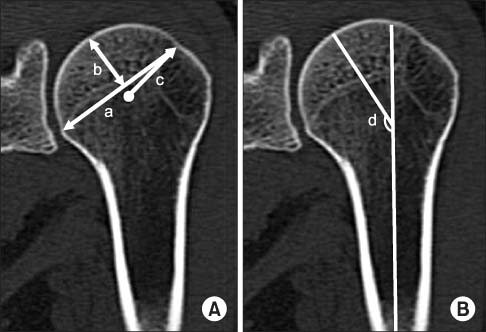J Korean Orthop Assoc.
2013 Oct;48(5):359-365. 10.4055/jkoa.2013.48.5.359.
Structural Analysis of Proximal Humerus in Korean
- Affiliations
-
- 1Department of Orthopedic Surgery, Kwandong University College of Medicine, Gangneung, Korea. seust@chollian.net
- 2Department of Orthopedic Surgery, Myongji Hospital, Goyang, Korea.
- 3Department of Orthopedic Surgery, Public Health & Medical Care Center, Yeoncheon, Korea.
- 4Department of Anatomy, Hanyang University College of Medicine, Seoul, Korea.
- KMID: 1494148
- DOI: http://doi.org/10.4055/jkoa.2013.48.5.359
Abstract
- PURPOSE
Third generation shoulder arthroplasty is widely performed nowadays; however, few studies on the anatomy of the proximal humerus in the Korean population have been reported. The authors have attempted to review the anatomy of the proximal humerus.
MATERIALS AND METHODS
The study sample consisted of 100 humeri of patients with a mean age of 48 years (range of 17 to 83 years) who underwent computed tomography imaging between January 2009 and October 2011 at Myongji Hospital. Diameter of the articular surface, head thickness, radius of curvature, head inclination, head to tuberosity height, bicipital groove-shaft angle, lateral angle, medial offset and posterior offset were analyzed. Results were compared depending on age and gender.
RESULTS
Mean values of diameter of the articular surface was 42.70+/-3.57 mm, head thickness was 14.3+/-2.0 mm, and radius of curvature was 22.50+/-1.97 mm; these three variables showed significant sex differences. Head inclination was measured as 130.00+/-4.28 degrees, head to tuberosity height was 7.50+/-0.99 mm, bicipital groove-shaft angle was 6.60+/-0.92 degrees, and lateral angle was 163.40+/-4.05 degrees. Mean medial and posterior offset were 5.2+/-2.1 mm and 3.1+/-1.8 mm, respectively.
CONCLUSION
Based on the results of this study, the measurement values of Korean humeri can be used in design of the arthroplasty prosthesis, and this will lead to more accurate anatomical reconstruction of the shoulder joint.
Keyword
MeSH Terms
Figure
Reference
-
1. Pearl ML, Kurutz S. Geometric analysis of commonly used prosthetic systems for proximal humeral replacement. J Bone Joint Surg Am. 1999; 81:660–671.
Article2. Boileau P, Walch G. The three-dimensional geometry of the proximal humerus. Implications for surgical technique and prosthetic design. J Bone Joint Surg Br. 1997; 79:857–865.3. Chun JM, Chung ER, Kim KY. Measurement of proximal humerus in Korean adult skeleton. J Korean Orthop Assoc. 1999; 34:219–226.
Article4. Jahng JS, Wee KM, Lee KH. The morphological study on the proximal part of the humerus in the Korean adults. J Korean Orthop Assoc. 1983; 18:507–512.
Article5. Court-Brown CM, Garg A, McQueen MM. The epidemiology of proximal humeral fractures. Acta Orthop Scand. 2001; 72:365–371.
Article6. Landis JR, Koch GG. The measurement of observer agreement for categorical data. Biometrics. 1977; 33:159–174.
Article7. Oh JH, Song BW. The current state of total shoulder arthroplasty. Clin Should Elbow. 2011; 14:253–261.
Article8. Bohsali KI, Wirth MA, Rockwood CA Jr. Complications of total shoulder arthroplasty. J Bone Joint Surg Am. 2006; 88:2279–2292.
Article9. Nuttall D, Haines JF, Trail IA. The effect of the offset humeral head on the micromovement of pegged glenoid components: a comparative study using radiostereometric analysis. J Bone Joint Surg Br. 2009; 91:757–761.10. Pearl ML, Volk AG. Retroversion of the proximal humerus in relationship to prosthetic replacement arthroplasty. J Shoulder Elbow Surg. 1995; 4:286–289.
Article11. Edelson G. Variations in the retroversion of the humeral head. J Shoulder Elbow Surg. 1999; 8:142–145.
Article
- Full Text Links
- Actions
-
Cited
- CITED
-
- Close
- Share
- Similar articles
-
- Homogenous Osteoarticular Transplantation of the Proximal Humerus: Report of A Case
- Early Intrathoracic Migration of K-wire Used for Fixation of Proximal Humerus Fracture
- Unrecognized bony Bankart lesion accompanying a dislocated four-part proximal humerus fracture before surgery: a case report
- Comparative study between operative and conservative treatment in 3 part and 4 part fracture of the proximal humerus
- PHILOS plate fixation with polymethyl methacrylate cement augmentation of an osteoporotic proximal humerus fracture



